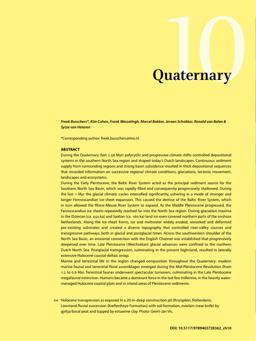2025-03-11
Geology of the Netherlands: Quaternary
Publication
Publication
During the Quaternary (last 2.58 Myr) polycyclic and progressive climate shifts controlled depositional systems in the southern North Sea region and shaped today’s Dutch landscapes. Continuous sediment supply from surrounding regions and strong basin subsidence resulted in thick depositional sequences that recorded information on successive regional climate conditions, glaciations, tectonic movement, landscapes and ecosystems. During the Early Pleistocene, the Baltic River System acted as the principal sediment source for the Southern North Sea Basin, which was rapidly filled and consequently progressively shallowed. During the last 1 Myr the glacial climatic cycles intensified significantly, ushering in a mode of stronger and longer Fennoscandian ice-sheet expansion. This caused the demise of the Baltic River System, which in turn allowed the Rhine-Meuse River System to expand. As the Middle Pleistocene progressed, the Fennoscandian ice sheets repeatedly reached far into the North Sea region. During glaciation maxima in the Elsterian (ca. 450 ka) and Saalian (ca. 160 ka) land ice even covered northern parts of the onshore Netherlands. Along the ice-sheet fronts, ice and meltwater widely eroded, reworked and deformed pre-existing substrates and created a diverse topography that controlled river-valley courses and transgressive pathways, both in glacial and postglacial times. Across the southwestern shoulder of the North Sea Basin, an erosional connection with the English Channel was established that progressively deepened over time. Late Pleistocene (Weichselian) glacial advances were confined to the northern Dutch North Sea. Postglacial transgression, culminating in the present highstand, resulted in laterally extensive Holocene coastal-deltaic onlap. Marine and terrestrial life in the region changed composition throughout the Quaternary: modern marine faunal and terrestrial floral assemblages emerged during the Mid-Pleistocene Revolution (from 1.2 to 0.8 Ma). Terrestrial faunas underwent spectacular turnovers, culminating in the Late Pleistocene megafaunal extinction. Humans became a dominant force in the last few millennia, in the heavily watermanaged Holocene coastal plain and in inland areas of Pleistocene sediments.
| Additional Metadata | |
|---|---|
| Released under the CC BY-NC-ND 4.0 (“Attribution-NonCommercial-NoDerivs 4.0 International”) Licence | |
| Organisation | Staff publications |
|
F. Busschers (Freek), K. Cohen (Kim), Wesselingh, F., M. Bakker (Marcel), J. Schokker (Jeroen), R. van Balen (Ronald), & S. van Heteren (Sytze). (2025). Geology of the Netherlands: Quaternary. In Geology of the Netherlands (pp. 333–391). |
|
